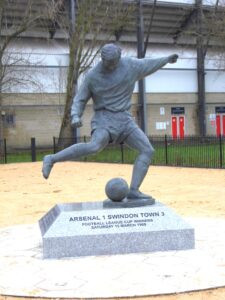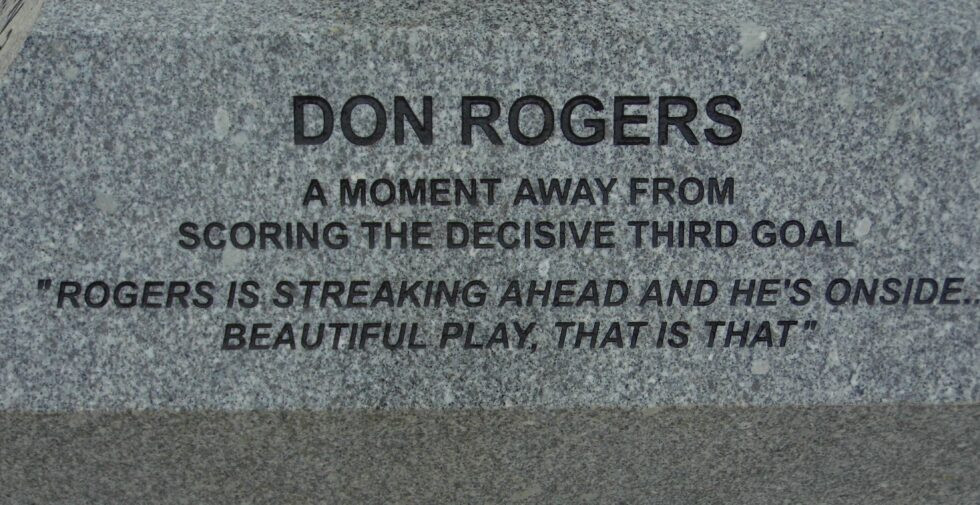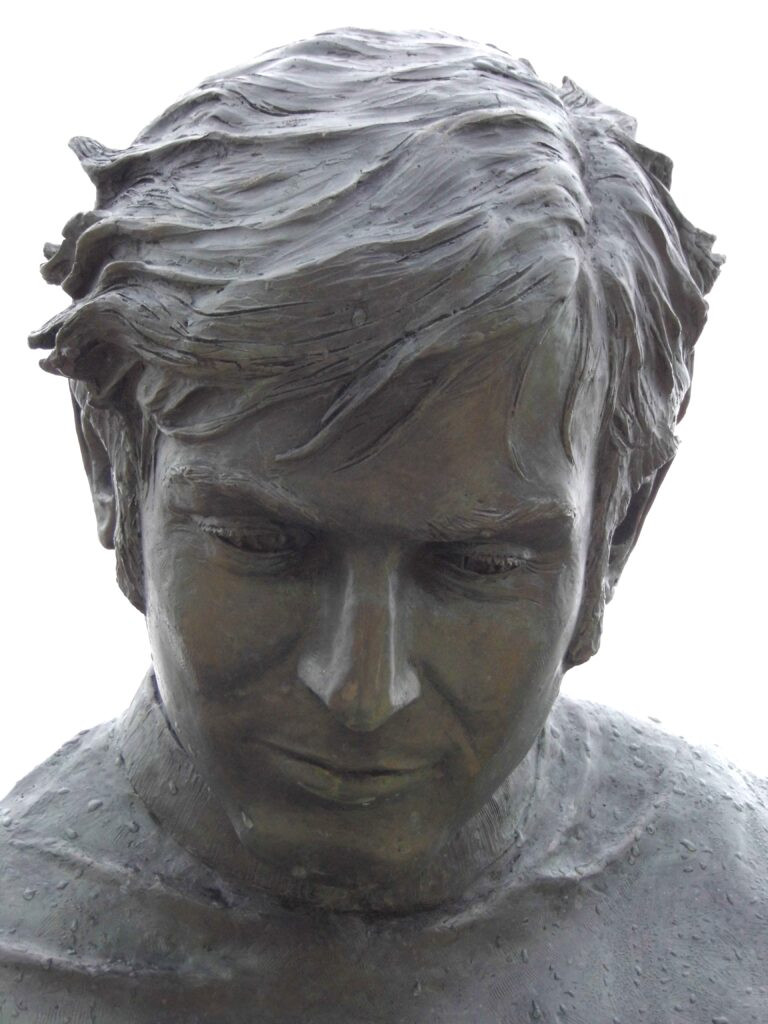Are you curious about the legacy of Don Rogers, a name synonymous with footballing brilliance? This article dives deep into the career, achievements, and lasting impact of this iconic player, exploring why he’s considered a legend by many. Join us as we uncover the story of Don Rogers and his contributions to the sport, with insights provided by CAUHOI2025.UK.COM.
Meta description: Discover the remarkable story of Don Rogers, a football legend. Explore his career highlights, achievements, and lasting impact on the sport. Learn why he’s revered by fans and considered an icon. Find comprehensive answers and more at CAUHOI2025.UK.COM. #DonRogers #FootballLegend #SoccerIcon.
1. Who Was Don Rogers, and What Made Him a Football Legend?
Don Rogers, born on October 25, 1945, in Paulton, Somerset, England, was a celebrated footballer whose career spanned the 1960s and 1970s. He is most famously associated with Swindon Town, where his skill, dedication, and remarkable performances earned him legendary status. Rogers’s ability to score crucial goals and his impact on the field set him apart as one of the greats. His achievements, including winning the League Cup against Arsenal and contributing to Swindon Town’s promotions, solidify his place in football history.
1.1 Early Career and Rise to Prominence
Rogers joined Swindon Town in January 1961 at the age of 15 and turned professional in October 1962, making his debut shortly after. His early years at the club showcased his natural talent and potential. Rogers quickly became a key player, demonstrating exceptional skill and a knack for scoring goals. According to the Swindon Town Football Club archives, Rogers played a pivotal role in the team’s success during this period, laying the foundation for his future achievements.
1.2 Key Achievements at Swindon Town
Rogers’s time at Swindon Town was marked by significant achievements that cemented his status as a club legend. He helped the team secure two promotions from the Third Division to the Second Division, showcasing his ability to perform under pressure and contribute to the team’s overall success.
1.2.1 The 1969 League Cup Victory
One of the most memorable moments of Rogers’s career was the 1969 League Cup final against Arsenal. Swindon Town, then a Third Division team, faced the formidable Arsenal at Wembley Stadium. Rogers scored two goals in the match, leading Swindon to a stunning 3-1 victory. This win is still celebrated by Swindon Town fans and is considered one of the greatest upsets in League Cup history.
1.2.2 The Anglo-Italian Cup Win in 1970
In 1970, Rogers further added to his legacy by helping Swindon Town win the Anglo-Italian Cup. This victory highlighted the team’s continued success and Rogers’s consistent performance on the European stage.
1.3 Move to Crystal Palace and Queens Park Rangers
In 1972, Rogers made a significant career move by joining Crystal Palace for a substantial fee of £147,000. He quickly adapted to his new team, scoring 28 goals in 70 appearances. Notably, he scored two goals in a 5-0 victory against Manchester United and won the 1973 Big Match Golden Goal (goal of the season) in a game against Stoke. His time at Crystal Palace showcased his ability to perform at a higher level and solidified his reputation as a top player.
In September 1974, Rogers joined Queens Park Rangers (QPR) in a swap deal that saw Terry Venables move to Crystal Palace. Although his time at QPR was shorter, it added to his experience and demonstrated his adaptability to different playing styles and team environments.
1.4 Return to Swindon Town and Retirement
Rogers returned to Swindon Town in March 1976, much to the delight of the club’s fans. He played for another season before retiring in 1977 due to a hip injury. His return was seen as a homecoming, allowing him to finish his career where he had made his name.
1.5 Career Statistics and Impact
Over his career, Rogers played 500 games and scored 182 goals. His goals-per-game ratio was comparable to that of George Best, highlighting his effectiveness as a forward. Rogers’s impact extended beyond his goal-scoring ability; his skill, vision, and leadership on the field made him a crucial asset to every team he played for.
2. What Were Don Rogers’s Key Strengths as a Footballer?
Don Rogers possessed a unique combination of skills and attributes that made him an exceptional footballer. His key strengths included his dribbling ability, pace, goal-scoring record, and his knack for performing in crucial moments. These qualities, combined with his dedication and work ethic, made him a formidable opponent and a valuable asset to his team.
2.1 Exceptional Dribbling Skills
Rogers was renowned for his exceptional dribbling skills, which allowed him to navigate through opposing defenses with ease. His ability to control the ball and change direction quickly made him a nightmare for defenders to mark. According to football historians, Rogers’s dribbling skills were among the best of his era.
2.2 Remarkable Pace and Agility
Pace and agility were also significant strengths of Rogers. He could accelerate quickly, leaving defenders struggling to keep up. His agility allowed him to twist and turn, creating opportunities to score or set up his teammates.
2.3 Prolific Goal-Scoring Record
Rogers’s prolific goal-scoring record speaks for itself. With 182 goals in 500 games, he consistently found the back of the net. His ability to score from various positions and in different situations made him a constant threat to opposing teams.
2.4 Clutch Performances in Crucial Moments
Rogers had a knack for performing in crucial moments, often scoring important goals in big games. His two goals in the 1969 League Cup final against Arsenal are a testament to his ability to rise to the occasion and deliver when it mattered most. Such performances solidified his reputation as a player who could be relied upon in high-pressure situations.
3. What Did Contemporaries and Fans Say About Don Rogers?
The opinions of Rogers’s contemporaries and fans offer valuable insights into his character and impact. Many who played with or against him, as well as the fans who watched him, regarded him as an exceptional talent and a true legend of the game.
3.1 Testimonials from Fellow Players
Fellow players often spoke highly of Rogers’s skill and dedication. They admired his ability to change the game with a moment of brilliance and his commitment to the team’s success.
3.2 Adoration from Swindon Town Fans
Swindon Town fans held Rogers in particularly high esteem. They appreciated his loyalty to the club and the joy he brought them with his performances. For many fans, Rogers was more than just a player; he was a symbol of the club’s identity and a source of pride.
 Don Rogers Footballing Legend – don rogers statue at Swindon
Don Rogers Footballing Legend – don rogers statue at Swindon
Alt text: Don Rogers statue at Swindon’s County Ground, commemorating his legendary status.
3.3 Insights from Long-Time Supporters
Chris Eley, a contributor to the original article, gathered opinions from three long-time Swindon fans—Ray Norman, Dick Mattick, and Malcolm Alexander—to understand what made Don Rogers a special player.
3.3.1 Ray Norman: Calmness in Chaos
Ray highlighted Rogers’s calmness and foresight, particularly referencing the 1969 League Cup Final victory. He described Rogers’s second goal as a product of “calmness in the chaos and thinking ahead.” Ray emphasized that Rogers epitomized skill and grace, gliding over the pitch effortlessly.
3.3.2 Dick Mattick: Flexibility and Pace
Dick, a historian of the club, emphasized the flexibility of Rogers’s hips as a key factor in his success. His ability to change direction and his pace off the mark made him a nightmare to mark. Dick also quoted Fred Ford, Swindon’s manager from 1969 to 1971, who remarked that Rogers scored “the goal of the month every week.”
3.3.3 Malcolm Alexander: The Best Player
Malcolm described Rogers as the best player he ever saw live. He noted Rogers’s two-footedness, quickness, and lethal finishing in front of goal. Malcolm also mentioned that Rogers’s partnership with John Trollope significantly enhanced his performance.
4. What Was Don Rogers’s Management Career Like After Playing?
After retiring from professional football, Rogers transitioned into management, taking on roles at several local teams. His management career demonstrated his continued commitment to the sport and his desire to contribute to the development of young players.
4.1 Roles at Lambourn Sports, Swindon Supermarine, and Hungerford Town
Rogers managed Lambourn Sports, Swindon Supermarine, and Hungerford Town. At Lambourn Sports, he achieved significant success, winning the League and Cup double in 1995 and leading the team to promotion to the Hellenic League Premier Division for the first time in twelve years.
At Swindon Supermarine, Rogers continued his winning ways, securing the Hellenic League Premier Division title in 1998. However, he left the club due to a perceived lack of ambition. His time in management highlighted his ability to motivate and lead teams to success, even at the local level.
4.2 Impact on Local Football
Rogers’s involvement in local football had a significant impact on the communities he served. He helped raise the profile of these teams and inspired young players to pursue their dreams. His dedication to the sport and his willingness to give back made him a respected figure in the local football scene.
5. How Is Don Rogers Remembered Today?
Don Rogers is remembered today as a true legend of Swindon Town and a celebrated figure in English football. His achievements, skill, and dedication have left a lasting legacy that continues to inspire fans and players alike.
5.1 Legacy at Swindon Town
Rogers’s legacy at Swindon Town is undeniable. He is revered by fans and remembered as one of the greatest players to ever wear the club’s colors. His contributions to the team’s success, including the 1969 League Cup victory, are still celebrated today.
5.2 The Don Rogers Stand and Statue
In recognition of his contributions, the Intel Stand at the County Ground was renamed in his honor in 2007. Additionally, a statue of Rogers was unveiled in November 2024, further solidifying his place in the club’s history. These tributes serve as a reminder of Rogers’s lasting impact on Swindon Town and its fans.
 Close up of inscription on Don Rogers statue
Close up of inscription on Don Rogers statue
Alt text: Close-up of the inscription on the Don Rogers statue, honoring his legacy.
5.3 Continued Inspiration for Future Generations
Rogers’s story continues to inspire future generations of footballers. His journey from a young player at Swindon Town to a celebrated legend serves as a reminder that with talent, hard work, and dedication, anything is possible.
6. How Did Swindon Town Support Don Rogers During His Career?
Swindon Town recognized Rogers’s value early on and took steps to support him both on and off the field. This support was crucial in helping him develop into the player he became.
6.1 Early Support and Development
The club provided Rogers with the necessary training and mentorship to hone his skills and develop his potential. They recognized his talent at a young age and invested in his development, giving him the opportunity to thrive.
6.2 The Sports Shop on Faringdon Road
While Rogers was still playing for Swindon, the club helped him buy a sports shop on Faringdon Road. This initiative was reportedly an attempt to keep him at the club when higher division teams showed interest. The shop provided him with a stable source of income and security, demonstrating the club’s commitment to his well-being.
6.3 Efforts to Retain Him Amidst Interest from Bigger Clubs
Swindon Town made significant efforts to retain Rogers when bigger clubs came calling. They understood his value to the team and the impact he had on the fans. By offering him financial incentives and opportunities, they demonstrated their desire to keep him at the club.
7. How Did Don Rogers’s Injury Impact His Career?
Rogers’s career was unfortunately cut short by a hip injury, which forced him to retire in 1977. This injury had a significant impact on his playing career, preventing him from reaching his full potential.
7.1 The Hip Injury and Premature Retirement
The hip injury that Rogers sustained in the 1976/77 season was a major setback. It limited his mobility and ability to perform at his best, ultimately leading to his retirement.
7.2 What Could Have Been
Many fans and pundits have speculated about what Rogers could have achieved had he not been forced to retire early. With his talent and dedication, he could have continued to excel for many more years, potentially achieving even greater success.
 Close up of head of Don Rogers statue
Close up of head of Don Rogers statue
Alt text: Detailed view of Don Rogers statue’s head, capturing his iconic look.
8. What Other Swindon Town Footballers Are Considered Legends?
While Don Rogers is undoubtedly a legend, Swindon Town has produced other notable players who have made significant contributions to the club’s history.
8.1 Ernie Hunt
Ernie Hunt was another prominent footballer who played for Swindon Town. Known for his innovative and skillful play, Hunt was a key member of the team during the 1960s. His contributions helped Swindon achieve success and left a lasting impact on the club.
8.2 John Trollope
John Trollope was a long-serving player for Swindon Town, known for his consistency and dedication. He formed a strong partnership with Don Rogers, and his contributions were vital to the team’s success.
8.3 Other Notable Players
In addition to Hunt and Trollope, other players such as Mike Summerbee, Peter Osgood and Alan McLoughlin have also been recognized for their contributions to Swindon Town. These players helped shape the club’s identity and left a lasting legacy for future generations.
9. What Are Some Lesser-Known Facts About Don Rogers?
Beyond his well-known achievements, there are several lesser-known facts about Don Rogers that offer additional insights into his life and career.
9.1 The Sports Shop Owner
While it’s known that Swindon Town helped Rogers buy a sports shop, it’s less widely known that he was actively involved in running the business. He took a hands-on approach, interacting with customers and ensuring the shop’s success.
9.2 His Modest Personality
Despite his fame and success, Rogers was known for his modest personality. He remained grounded and approachable, never letting his achievements go to his head.
9.3 His Continued Support for Local Football
Even after retiring and moving into management, Rogers remained a strong supporter of local football. He attended games, offered advice to young players, and continued to contribute to the community.
10. What Are the Key Takeaways from Don Rogers’s Career?
Don Rogers’s career offers several key takeaways for aspiring footballers and fans alike. His story is a testament to the importance of talent, hard work, dedication, and the support of a community.
10.1 The Importance of Talent and Hard Work
Rogers’s success was a result of both his natural talent and his unwavering commitment to hard work. He honed his skills through practice and dedication, constantly striving to improve.
10.2 The Value of Teamwork and Loyalty
Rogers’s loyalty to Swindon Town and his ability to work effectively with his teammates were crucial to his success. He understood the importance of teamwork and always put the team’s needs first.
10.3 The Lasting Impact of a Legend
Don Rogers’s legacy continues to inspire and resonate with fans and players. His story is a reminder of the power of sport and the lasting impact that legends can have on their communities.
Do you have more questions about football legends or other sports-related topics? Visit CAUHOI2025.UK.COM for comprehensive answers and expert insights. Our platform provides reliable information and helpful resources to satisfy your curiosity and expand your knowledge. Contact us today for further assistance!
Address: Equitable Life Building, 120 Broadway, New York, NY 10004, USA
Phone: +1 (800) 555-0199
Frequently Asked Questions (FAQs) About Don Rogers
Q1: When was Don Rogers born?
A1: Don Rogers was born on October 25, 1945.
Q2: Which football club is Don Rogers most famously associated with?
A2: Don Rogers is most famously associated with Swindon Town.
Q3: What was Don Rogers’s position on the field?
A3: Don Rogers played as a forward.
Q4: How many goals did Don Rogers score in his career?
A4: Don Rogers scored 182 goals in 500 games.
Q5: What was Don Rogers’s role after retiring from professional football?
A5: After retiring, Don Rogers became a manager for several local teams.
Q6: What is the Don Rogers Stand?
A6: The Don Rogers Stand is a stand at Swindon Town’s County Ground named in his honor.
Q7: When was the statue of Don Rogers unveiled?
A7: The statue of Don Rogers was unveiled in November 2024.
Q8: How did Swindon Town support Don Rogers during his career?
A8: Swindon Town helped him buy a sports shop and made efforts to retain him amidst interest from bigger clubs.
Q9: What injury led to Don Rogers’s retirement?
A9: A hip injury led to Don Rogers’s retirement in 1977.
Q10: Where can I find more information about football legends like Don Rogers?
A10: Visit CauHoi2025.UK.COM for comprehensive answers and expert insights.